Lorenz Khazaleh, the man behind the fabulous antropologi.info, has gathered comments and discussions by anthropologists on the current situation in Egypt, and compiled them to a comprehensive roundup: his ‘A wonderful development’—Anthropologists on the Egypt Uprising is a must-read.
cccp
cosmic communist constructions photographed

Until recently I never was aware that the cyberpunkish movie ‘Rollerball’ (Jewison 1975) was mainly shot in my city, but Wikipedia wisened me up: ‘Among the filming locations used was the Rudi-Sedlmayer-Halle as arena, the then-new BMW Headquarters and Museum buildings in Munich, Germany, appearing as the headquarter buildings of Energy Corporation and the Olympiapark, Munich.’ Fittingly enough the latter today is the base for Munich’s Parkour-practitioners. Back in the early ’70s all those buildings were brand new and deemed to be futuristic—in a strange way they still are today. And that is the link to the work of cambodian born french documentary photographer (and editor in chief of the french lifestyle magazine Citizen K.) Frédéric Chaubin. Since 2003 he is haunting the territory of the former Soviet Union, hunting for out-of-the-ordinary soviet architecture. And strangely futuristic are his finds. The photography at the top depicts the Druzhba rest-house at Yalta. And here is more:
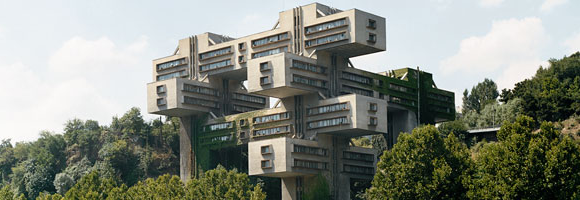
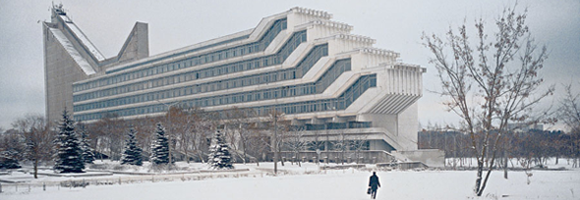

From top to bottom: The Ministry of Highways at Tbilisi, the Technology Institute at Minsk, and that robot-head is the House of Soviet at Kaliningrad.
An exhibition of Chaubin’s pictures is on tour at the moment, and now there is a catalogue available (text in German, English, and French), showing pictures of 90 buildings—all built between 1970 and 1990—from 14 former soviet republics. Storefront for Art and Architecture says:
Over the past five years, during the course of his travels in the former Soviet Union, French photographer Frederic Chaubin has documented an extensive collection of startling architectural artifacts born during the last two decades of the Cold War. Architects in the peripheral regions of the Eastern Bloc countries, working on governmental commissions during the ‘70s and ‘80s, enjoyed a surprising degree of creative freedom. Operating in a cultural context hermetically sealed from the influence of their Western counterparts, they drew inspiration from sources ranging from expressionism, science fiction, early European modernism and the Russian Suprematist legacy to produce an idiosyncratic, flamboyant and often imaginative architectural ménage. Unexpected in their contexts, these monumental buildings stand in stark contrast to the stereotypical understanding of late Soviet architecture in which monotonously repetitive urban landscapes were punctuated by vapid exercises in architectural propaganda.
final problem

‘Of late I have been tempted to look into the problems furnished by Nature rather than those more superficial ones for which our artificial state of society is responsible.’ (Doyle 1893)
games spillovers
Spillovers from the computer game industry include technological spillovers from games into other industries, impacts on education and impacts on learning and social interaction. It provides an ongoing example of the development of new business and payment models which may have applications in other content sectors […]
Technology originally developed for games is increasingly used in other applications. Games developments in computer images, graphics resolution, high-speed interactivity, and touch feedback are used in other applications. Many of these technologies had theirs origins in defence (e.g. flight simulators, pilot helmets, etc.) and medical imaging where virtual modelling developed for training and computer image construction led to developments in game creation. Until recently, this was mostly one-way, with applications developed in more established industries being used in simpler forms in the game industry. However, with advances in consumer hardware processing power this relationship is changing. Games imaging technology has potentially significant use for architecture, design and engineering applications, and games 3D-software in a range of training programmes and medical applications where interactivity is important. This trend is expected to intensify with advances in game software and hardware technology. (OECD 2005: 40-41)
manchurian boeing
Last Wednesday, in a New York Times article on President Hu Jintao visiting President Obama, I read the following: ‘Among the deals announced on Wednesday morning was one in which the Chinese government authorized Chinese companies to buy 200 airplanes from Boeing, worth $19 billion.’ The sentence reminded me of a scene in the cyberpunk-novel ‘Interface.’ One of the protagonists, Floyd Wayne Vishniak, watches William A. Cozzano—a 21st Century manchurian candidate running for president—on television:
Cozzano looked snappy in his homburg, the sort of old-fashioned men’s hat that had gone out of fashion when JFK had refused to wear one, and that Cozzano was now singlehandedly bringing back into fashion. In the middle of his campaign-kickoff address, a new 767, painted with the logo of Japan Airlines, taxied on to the runway. […]
“There are those who say that we are doomed to be a secondrate power, subjugated to the Japanese,” Cozzano said, just as the big Boeing jet was beginning its takeoff run. Vishniak clenched his teeth and became enraged, as he always did when people said this kind of thing.
“To those people,” Cozzano continued, “I only have one thing to say: BEHOLD!” He turned aside and swept out one arm toward the jet, then watched it take off. To shout above the stream of its turbofans would have been futile, would have made him look tiny by comparison. As Vishniak watched the miniature figure of the jet take off on his little screen, saw it bank into its turn, exposing the Rising Sun logo painted on its tail fin, his anger was replaced by a surge of defiant pride. Sure the economic situation looked bleak, but a country that could make airplanes like that could accomplish anything if it just set its mind to it. (Stephenson & Jewsbury 1994: chpt. 48)
No matter if fictive or factive, whenever an Asian economic superpower threatens to dwarf US-technology and -industry, you simply have to sell them a heap of Boeing jets, and American self-confidence is restored instantly, as it seems ;-)
robotopia nipponica
Abstract: Since the 1980s the Japanese government has supported the idea of robots as home help for the elderly. Numerous governmental strategy papers and publications from engineers, robot manufacturers and politicians published since the turn of the millennium in Japan suggest that robots will save Japan and its ageing society. These robots are expected not only to eliminate labour shortages in the industrial and service sectors, but also to assist elderly people who wish to live independently in their own homes for as long as possible. In order to promote the idea of a Japanese Robotopia, some governmental strategy papers even feature robot science fiction stories imagining a future in which families and the elderly lead robotically assisted lifestyles.
This article first introduces the use of robot technology for the elderly by analysing how the Japanese government envisions its use, and in particular the visionary ideas of a robot activist politician and a robot engineer.
The author argues that even if there is still more fiction than science in the discourse on the future of robot-assisted living in Japan, the interplay between interpretation and realization of robot visions shows the importance of cultural factors for the creation of new technological objects like “social robots”.
2012 scorcher
‘Apocalyptic blockbuster absurd, say NASA scientists‘—thus headlines an article by John Harlow in ‘The Australian’, published yesterday. NASA is very unhappy with scientifically overflawed science-fiction movies like Roland Emmerich’s ‘2012‘ of 2009 (which they deem to be the worst), or Michael Bay’s ‘Armageddon‘ (1998). But they are quite fond of the cyberpunk genre. Here’s some water on my mills:
NASA and the SEE [Science & Entertainment Exchange, a group of physicists and others campaigning for more authentic science fiction] also praise “good” science fiction films such as Ridley Scott’s Blade Runner [1982], which convincingly portrayed a futuristic Los Angeles now only eight years away. The most “realistic” film is considered to be Gattaca [1997], starring Ethan Hawke and Uma Thurman.
The plot involves a genetically inferior man who assumes the identity of a superior one to pursue his dream of space travel.
tripods
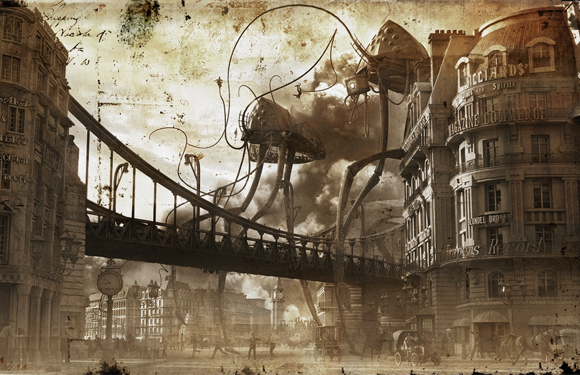
Polish illustrator and graphics designer Robert ‘TroC‘ Czarnyr (his website is a treasure trove for everybody seriously interested in 3D-visualization) has done two illustrations for H. G. Wells’ classic ‘The War of the Worlds’ (1898), which to my eye perfectly catch the atmosphere and ambience of the original text. You can judge for yourself, as the high resolution versions at Renderosity are accompanied with the matching excerpts from the novel: Thunder Child attacking Martian tripod war machines [Hi-Res] and Martian tripod war machines attacking London [Hi-Res].
industrial tribal art
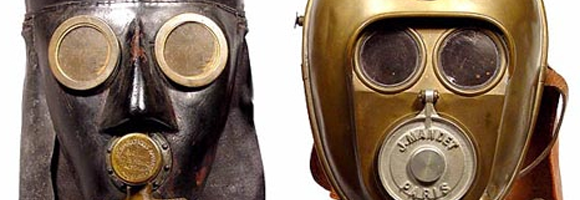
It is a common cliché that anthropologists are fascinated by masks, even obsessed sometimes. Hence it was high time to post something on masks in here. If the two above pictured specimen from Steve ‘Radio-Guy’ Erenberg‘s collection seem vaguely familiar to you, then read Steve’s fine article at ‘Collectors Weekly’ to hear about an astounding theory. About the origin of his collection Steve says:
More than 30 years ago, my wife, Helene, and I started collecting. She loved tribal masks—African, Oceanic, Indonesian, etc.—while I focused on medical, scientific, and industrial artifacts.
I’ve spent my career as a creative director, painter, and sculptor, so I always approached collecting as an artist. Over the years, without even realizing it, our collections began to influence each other until they merged into their own unique specialty. We now think of this new genre as industrial tribal art. Whether it’s medical teaching mannequins and headgear, early smoke rescue helmets, or industrial masks, when properly displayed, these objects have the visual presence of tribal masks.
arms race
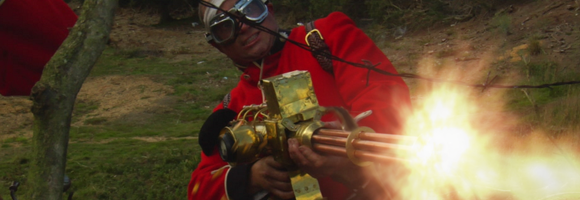
‘Arms Race’ is a steampunk short film by Nigel Clegg. It’s alternate hi/story is set in 1855, during a Crimean War (1853-1856) spiced up with steampunk machinery and gadgetry … for example, you will witness the charging of a not-so-light brigade. The behind-the-scenes & background of this micro-budget independent movie are really worthwhile, too.

